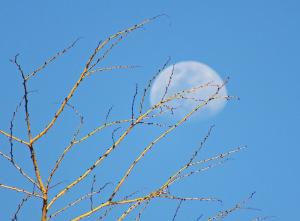I’m not long back from two weeks traveling in Kenya. This was a field trip with a brilliant group of lecturers and students from the University of Exeter’s Penryn campus, and there was lots to learn, see and do.
Kenya is very different from Cornwall, needless to say, in many ways. It was sunny, for one thing, unlike the current rather dismal weather we are having here! The animals are different, and the plants are different, and even the night skies are different. The constellation of Orion was much higher in the sky and the wrong way round, for one thing, and the moon was flipped over onto its side.

The moon is turned on its side at the equator (photo: Amanda Scott). If you rotated this photo one quarter turn clockwise, then that’s the view of the moon we have in the northern hemisphere.
But, most magnificently, the skies were so clear away from urban areas. Some of us spent a happy time pointing our smartphones at the skies using the Night Sky app to identify all the stars we could see. The Milky Way was visible, arching across the sky, most nights. It was all very, very beautiful.
Now in fact I get a pretty good view of the night sky from my back garden here in West Cornwall, including the Milky Way, on cloudless nights. That’s because I back on to fields and there is very little light spill from neighbouring houses later in the evening. Even so, I don’t think it would qualify for “Dark SkyDiscovery Site” status, an award given by the Science and Technology Facilities Council (STFC) to places deemed to be of very high quality for stargazing because of the lack of light pollution. But we do now have two sites on the north coast of Cornwall that have recently been successful in achieving this status: St. Agnes Head, and the Carnewas and Bedruthan Steps. Both sites are owned by the National Trust and have had to meet stringent criteria: the Milky Way must be visible, and they must have good access for the public, including people with disabilities.
It’s not the weather at the moment for stargazing (unlike Kenya!), but it’s good to know there is somewhere close by to visit when the skies get clearer and the weather improves…
![Night skies over Cornwall Photo: Michael J. Bennett (Own work) [CC-BY-SA-3.0 (http://creativecommons.org/licenses/by-sa/3.0)], via Wikimedia Commons](http://m5.paperblog.com/i/78/784518/night-skies-over-cornwall-L-VqmdUr.jpeg)
Photo: Michael J. Bennett (Own work) [CC-BY-SA-3.0 (http://creativecommons.org/licenses/by-sa/3.0)%5D, via Wikimedia Commons
here
